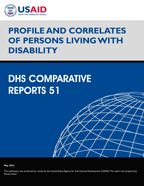There is no printed copy available to order.
Abstract:
It is estimated that approximately 15% of the global population live with a disability and this can vary greatly by country and by population subgroups. It is important for countries to identify persons living with
disabilities (PWD) in order to provide them with the services and support they need. This report uses data from DHS surveys in Haiti, Mali, Nigeria, Pakistan, Rwanda, Senegal, South Africa, Timor-Leste, and Uganda to describe the characteristics of PWD. The surveys used the Washington Group Short Set of questions to measure disability levels. Three measures of disability were constructed: having any disability, having any severe disability, and having two or more disabilities. Having any disability or any severe disability was found to be the lowest in Nigeria (8.3% any, 1.4% severe) and the highest in Uganda (26.3% any, 6.5% severe). However, six out of the nine countries had more than 15% of persons living with any
disability, and seeing was the most prevalent type of disability, regardless of severity. Among the population age 5 and over, the highest percentage of PWD was found in females, in those age 50 and above, and in rural areas of most countries. For women and men age 15 and above, disability was found to be higher in those with no education, those formally in a union, those who have four or more children, and for those who are currently working. Significant differences in disability were also found by religion and ethnicity, especially among women in Nigeria and Uganda. Few significant associations were found between the disability measures and experience of domestic violence. The exception was among Ugandan women, where women who have experienced different forms of violence had a higher percentage of disability for all three disability measures. While further analysis is needed to explore these disparities in depth, the report helps to identify where inventions are needed to either support PWD directly or through improvements in infrastructure and health services.
 Profile and Correlates of Persons Living with Disability (PDF, 1819K)
Profile and Correlates of Persons Living with Disability (PDF, 1819K)
 Profile and Correlates of Persons Living with Disability (CR51) - Analysis Brief
Profile and Correlates of Persons Living with Disability (CR51) - Analysis Brief
